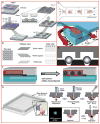Opportunities and challenges for use of tumor spheroids as models to test drug delivery and efficacy
- PMID: 22613880
- PMCID: PMC3436947
- DOI: 10.1016/j.jconrel.2012.04.045
Opportunities and challenges for use of tumor spheroids as models to test drug delivery and efficacy
Abstract
Multicellular spheroids are three dimensional in vitro microscale tissue analogs. The current article examines the suitability of spheroids as an in vitro platform for testing drug delivery systems. Spheroids model critical physiologic parameters present in vivo, including complex multicellular architecture, barriers to mass transport, and extracellular matrix deposition. Relative to two-dimensional cultures, spheroids also provide better target cells for drug testing and are appropriate in vitro models for studies of drug penetration. Key challenges associated with creation of uniformly sized spheroids, spheroids with small number of cells and co-culture spheroids are emphasized in the article. Moreover, the assay techniques required for the characterization of drug delivery and efficacy in spheroids and the challenges associated with such studies are discussed. Examples for the use of spheroids in drug delivery and testing are also emphasized. By addressing these challenges with possible solutions, multicellular spheroids are becoming an increasingly useful in vitro tool for drug screening and delivery to pathological tissues and organs.
Copyright © 2012 Elsevier B.V. All rights reserved.
Figures




References
-
- Han C, Wang B. Factors that impact developability of drug candidates: an overview. In: Wang B, Siahaan T, Soltero R, editors. Drug Delivery: Priciples and Applications. John Wiley & Sons; Hoboken, New Jersey: 2005. pp. 1–14.
-
- Saltzman WM. Drug Delivery: Engineering Principles for Drug Therapy. Oxford University Press; New York: 2001.
-
- Torchilin VP. Passive and active drug targeting: drug delivery to tumors as an example. In: Schafer-Korting M, editor. Drug Delivery. Springer; 2010. pp. 3–54. - PubMed
-
- Jain KK. Drug Delivery Systems- An Overview. In: Jain KK, editor. Drug Delivery Systems. Humana Press; 2008. pp. 1–50. - PubMed
-
- Karunaratne DN, Silverstein PS, Vasadani V, Young AM, Rytting E, Yops B, Audus KL. Cell culture models for drug transport studies. In: Wang B, Siahaan T, Soltero R, editors. Drug Delivery: Priciples and Applications. John Wiley & Sons; Hoboken, New Jersey: 2005. pp. 103–124.
Publication types
MeSH terms
Substances
Grants and funding
LinkOut - more resources
Full Text Sources
Other Literature Sources

